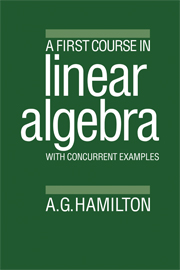Book contents
- Frontmatter
- Contents
- Preface
- 1 Gaussian elimination
- 2 Solutions to simultaneous equations 1
- 3 Matrices and algebraic vectors
- 4 Special matrices
- 5 Matrix inverses
- 6 Linear independence and rank
- 7 Determinants
- 8 Solutions to simultaneous equations 2
- 9 Vectors in geometry
- 10 Straight lines and planes
- 11 Cross product
- Answers to exercises
- Sample test papers
- Further reading
- Index
3 - Matrices and algebraic vectors
Published online by Cambridge University Press: 24 October 2009
- Frontmatter
- Contents
- Preface
- 1 Gaussian elimination
- 2 Solutions to simultaneous equations 1
- 3 Matrices and algebraic vectors
- 4 Special matrices
- 5 Matrix inverses
- 6 Linear independence and rank
- 7 Determinants
- 8 Solutions to simultaneous equations 2
- 9 Vectors in geometry
- 10 Straight lines and planes
- 11 Cross product
- Answers to exercises
- Sample test papers
- Further reading
- Index
Summary
A matrix is nothing more than a rectangular array of numbers (for us this means real numbers). In fact the arrays which were part of the shorthand way of carrying out the Gaussian elimination process are matrices. The usefulness of matrices originates in precisely that process, but extends far beyond. We shall see in this chapter how the advantages of brevity gained through the use of arrays in Chapters 1 and 2 can be developed, and how out of this development the idea of a matrix begins to stand on its own.
An array of numbers with p rows and q columns is called a p × q matrix (‘p by q matrix’), and the numbers themselves are called the entries in the matrix. The number in the ith row and jth column is called the (i,j)-entry. Sometimes suffixes are used to indicate position, so that aij (or bij, etc.) may be used for the (i,j)-entry. The first suffix denotes the row and the second suffix the column. See Examples 3.1. A further notation which is sometimes used is [aij]p × q. This denotes the p × q matrix whose (i,j)-entry is aij, for each i and j.
Immediately we can see that there are extremes allowed under this definition, namely when either p or q is 1. When p is 1 the matrix has only one row, and is called a row vector, and when q is 1 the matrix has only one column, and is called a column vector.
- Type
- Chapter
- Information
- A First Course in Linear AlgebraWith Concurrent Examples, pp. 23 - 32Publisher: Cambridge University PressPrint publication year: 1987



